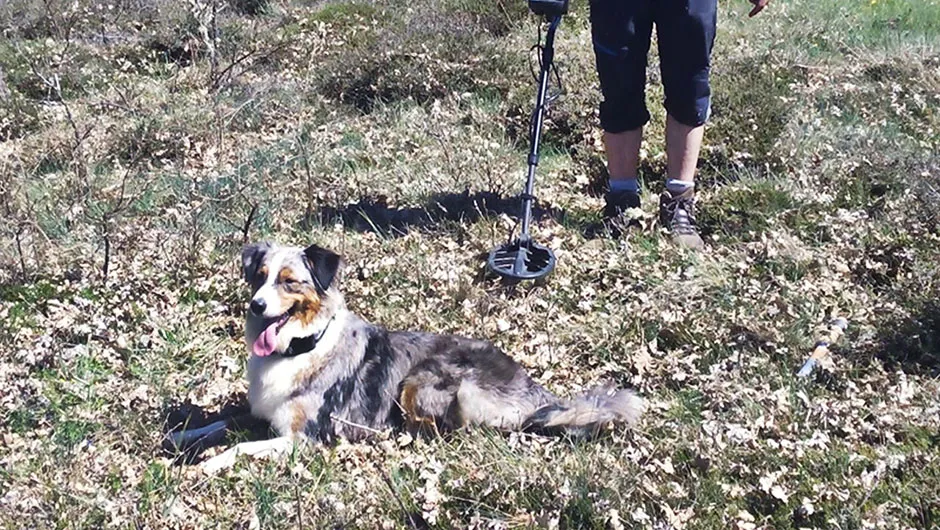Daniel (pictured front) and the team prepare Kaly for her first meteorite hunting expedition. Image Credit: Daniel Garcia Bernal
The study of meteorites is really a fundamental field in astronomy and science, due to the information about the Universe we can acquire from these visiting celestial bodies.
Analysing the properties of meteorites that land on Earth from space teaches us so much about the chemical and geological processes occurring in our own Solar System and beyond.
The process of searching for meteorite fragments often begins with the sighting of a fireball.
Thanks to witness testimony, photographs and video recordings, meteorite-seekers are usually able to calculate a meteorite’s trajectory and impact point on Earth.
An estimated 500 meteorites make it to the surface of our planet every year, yet no more than five or six are found.
This is because most hit the ground at a relatively slow speed and do not cause very large impact craters, while others simply land in the ocean or other out-of-reach places.
As a result, meteorite hunting can be a very tricky business, even for teams of humans working together.
Being interested in geology and astronomy, this is a problem I have been aware of for some time.
Through my work training police sniffer dogs, it occurred to me that the smelling power of our canine friends might make them efficient meteorite-hunters.
Working with the Rubí Local Police Department in Barcelona and the Polytechnic University of Catalonia (UPC), the plan was to train a canine unit in order to provide, for the first time, a dog that could detect and locate meteorites on Earth.
I put forward my own sniffer dog Kaly for the purposes of the project.
Kaly is a female Australian Shepherd; a breed that makes for good search and rescue dogs due to their incredibly heightened senses and intelligence.
The idea was to train Kaly to be able to seek out meteorites quicker than humans can, and in areas where technical equipment can’t reach or where humans simply cannot see.
The method is not entirely new. In the 1970s in northern Europe dogs were used to find nickel sulphide to satisfy the growing demand of the steel industry sector.
Reports show how one dog was trained to locate nickel sulphide in a 3 km2 field and was able to find 1,330 sulphide stones located 20cm deep in the ground.
A nose for success

The aim of this current project in meteor hunting is to exponentially increase the area that can be searched, requiring less human resources and accessing more difficult-to-reach places.
The specific canine training required for the project was developed with the help of Rubí police agent Daniel Pastor Marin, because there is really no precedent in this field.
Analysing the chemical structure of the meteorites was left to UPC, in order to discover the most valuable substances to the dog’s smell ‘memory’.
This process lasted for about two months, using the ‘odorant colonisation’ method of Doctor Mario Rosillo, an expert in olfaction and a co-operator on the project.
The term ‘colonisation’ refers to the act of applying an odorant to the dog’s smell receptors through its nose in order to establish an odorant colony.
This enables the dog to seek out certain smells over others.
The technique had already been used in narcotics, explosives, counterfeiting and the detection of diseases so, I thought, why not meteorites?
The hunt for space rocks

The culmination of this training and research was a project that took place on 15 May 2015 in Villabeto de la Peña (Spain), the site of a fireball and a shower of meteorite fragments that hit Earth in 2004.
Present were Jordi Llorca, professor at UPC, José Vicente Casado, a meteorite and ancient fossils lecturer, and Josep Maria Bosch Ignes, professor at the Astrophysics Institute of Canaries and researcher of asteroids.
The technical aspect was directed by Daniel Pastor Marin, myself and, of course, my dog Kaly.
The results of the experiment were higher than expected, amounting to an outstanding search mission that confirmed for the first time dogs could in fact be used to seek out meteorites efficiently.
The experiment lasted two days in total, with Kaly working from 9am until 7pm, searching for 35 minutes and resting 20 minutes at a time.
UPC had provided three meteorites for the experiment, which had been found after a fall over Tunisia in 2008.
These were placed in the ground at the site by a team of scientists from the university, wearing special suits and gloves to prevent the meteorites from picking up the scent of humans.
As well as these, Kaly also uncovered something of a shock for the team; some Roman nails and a ring of iron and nickel that were stuck about 30cm deep in the ground.
The ring is thought to be about 200 years old and was found by Kaly because its chemical composition is similar to that of meteorites.
Following these results and Kaly’s success in finding the meteorites, the project is now moving to the sites of more recent meteorite falls in Lleida, Catalonia and Cordoba, Andalusia.
We are also preparing an international operating team to search for celestial material in Chile.
The importance of this project is to get more information on these substances to study the source of life on Earth.
Research and recovery of this material will be of great importance to science and astronomy for many years to come, and our canine meteorite hunters will be able to play a vital role in this endeavour.
To my mind, and as far as I am aware, there is no greater detector than the nose of a well-trained dog!
Daniel Garcia Bernal is an instructor in dog training at the University Autónoma of Barcelona and works in the canine division of security firm Barna Seguretat K9.